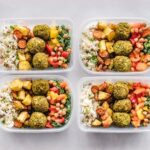Gluten-free baking can be a challenge, but with the right tips and tricks, it can also be a delicious and healthy experience. Whether you have celiac disease, a gluten intolerance, or simply want to cut back on gluten, these 10 tips will help you create tasty treats that everyone can enjoy.
- 1. Gluten-Free Flour Options
- 1.1. Almond Flour
- 1.2. Coconut Flour
- 1.3. Buckwheat Flour
- 1.4. Corn Flour
- 1.5. Rice Flour
- 2. Baking Techniques for Gluten-Free Recipes
- 2.1. Use Xanthan Gum or Guar Gum
- 2.2. Add Extra Eggs or Egg Whites
- 2.3. Increase Liquid Ingredients
- 2.4. Avoid Over-Mixing the Batter
- 2.5. Let the Batter Rest Before Baking
- 3. Gluten-Free Baking Tips and Tricks
1. Gluten-Free Flour Options
When it comes to gluten-free baking, finding the right flour can make all the difference. Here are some popular gluten-free flour options:
– Almond flour: made from ground almonds, this flour adds a nutty flavor and moisture to baked goods
– Coconut flour: high in fiber and low in carbohydrates, this flour absorbs a lot of liquid and can be tricky to work with
– Rice flour: a versatile flour that can be used in a variety of baked goods
– Buckwheat flour: despite its name, buckwheat is actually a seed and is gluten-free. It has a slightly nutty flavor and works well in pancakes and waffles
– Oat flour: make sure to use certified gluten-free oat flour to avoid cross-contamination. Oat flour adds a mild flavor and soft texture to baked goods
Experiment with different flours to find the right one for your recipe and taste preferences.
1.1. Almond Flour
Almond flour is a popular gluten-free flour option that can be used in a variety of baking recipes. Made from ground almonds, it is high in protein and healthy fats, making it a nutritious choice for those who are gluten-free. Almond flour can be used in everything from cakes and cookies to breads and pancakes, and it adds a delicious nutty flavor to baked goods. When using almond flour in recipes, be sure to adjust the liquid ingredients accordingly, as it absorbs moisture differently than wheat flour.
1.2. Coconut Flour
Coconut flour is a popular gluten-free flour option that is not only nutritious but also delicious. It is made from finely ground coconut meat and has a mild coconut flavor. Coconut flour is high in fiber, protein, and healthy fats, making it a great choice for those looking to add more nutrients to their diet. It is also low in carbohydrates and has a low glycemic index, making it a good option for those with diabetes or trying to manage their blood sugar levels. When using coconut flour in recipes, it is important to note that it absorbs more liquid than traditional wheat flour, so you may need to adjust the amount of liquid in your recipe accordingly. Coconut flour can be used in a variety of recipes, including pancakes, muffins, and even pizza crust!
1.3. Buckwheat Flour
Buckwheat flour is a popular choice for those following a gluten-free diet. Despite its name, buckwheat is not related to wheat and is actually a fruit seed. It has a nutty flavor and is rich in protein and fiber, making it a healthy choice for baking. Buckwheat flour can be used in a variety of baked goods, such as pancakes, muffins, and bread. It is also a great option for those with celiac disease or gluten sensitivity.
1.4. Corn Flour
Corn flour is a great gluten-free flour option for baking. It is made from finely ground cornmeal and has a slightly sweet flavor. Corn flour can be used in a variety of recipes, including bread, muffins, and cakes. However, it is important to note that corn flour is not a direct substitute for wheat flour, so adjustments may need to be made to other ingredients in the recipe.
1.5. Rice Flour
Rice flour is a popular gluten-free alternative to wheat flour in baking. It is made from finely ground rice and can be used in a variety of baking recipes, from cakes and cookies to bread and pizza dough. Rice flour is also a great thickener for soups, sauces, and gravies. When using rice flour in baking, it is important to note that it does not have the same binding properties as wheat flour, so it may be necessary to use a binding agent such as xanthan gum or guar gum. Additionally, rice flour has a slightly sweet taste and a light texture, which can add a unique flavor and texture to your baked goods.
2. Baking Techniques for Gluten-Free Recipes
When it comes to baking gluten-free treats, there are a few key techniques that can help ensure success. Firstly, it’s important to use a blend of gluten-free flours, as relying on just one type can result in a dense or crumbly texture. Experiment with different blends, such as rice flour, almond flour, and tapioca starch, to find the right combination for your recipe. Additionally, adding xanthan gum or guar gum to your batter can help bind the ingredients together and create a more cohesive texture. Another important technique is to use precise measurements, as gluten-free flours can be more finicky than wheat flour. Invest in a digital kitchen scale for the most accurate results. Finally, don’t overmix your batter, as this can cause it to become tough and dry. Mix just until the ingredients are combined, then stop. With these tips in mind, you’ll be able to whip up delicious and healthy gluten-free treats with ease.
2.1. Use Xanthan Gum or Guar Gum
When it comes to gluten-free baking, xanthan gum and guar gum are two commonly used ingredients to help give structure and elasticity to baked goods. Xanthan gum is made from fermented corn sugar and guar gum is made from the guar bean. Both are used as thickeners and emulsifiers in a variety of foods, but in gluten-free baking they are particularly useful as binders to replace the gluten that is missing. Xanthan gum is more commonly used in smaller amounts, while guar gum is used in larger amounts. It’s important to use the recommended amount of gum in a recipe to avoid a gummy or slimy texture. Experimenting with different amounts and ratios of gums can also help achieve the desired texture in gluten-free baked goods.
2.2. Add Extra Eggs or Egg Whites
Adding extra eggs or egg whites is a simple and effective way to improve the texture and structure of gluten-free baked goods. Eggs provide moisture, richness, and protein, which are all essential for achieving a tender and fluffy crumb. In general, you can add one or two extra eggs or egg whites to a recipe without altering the flavor significantly. However, keep in mind that too many eggs can make the batter too thick or heavy, so it’s important to balance the amount of eggs with the other ingredients. Another option is to use egg replacers or other binding agents, such as xanthan gum or guar gum, which can mimic the properties of gluten and help the dough or batter hold together.
2.3. Increase Liquid Ingredients
One of the biggest challenges of gluten-free baking is achieving the right texture. Many gluten-free flours tend to be denser and drier than wheat flour, which can result in baked goods that are crumbly or dry. One way to combat this is by increasing the amount of liquid ingredients in your recipes. This can help to create a moister and more tender final product. When adapting a recipe, try increasing the amount of milk, water, or other liquid ingredient by a small amount and see how it affects the texture. You may need to experiment a bit to find the right balance, but with a little practice, you can create delicious gluten-free baked goods that rival their wheat-based counterparts.
2.4. Avoid Over-Mixing the Batter
One of the key things to keep in mind when baking gluten-free treats is to avoid over-mixing the batter. Unlike traditional wheat-based batters, gluten-free flours can become tough and gummy if they are overworked. It’s important to mix the batter just until all of the ingredients are combined, and then stop. Also, be sure to use a light hand when folding in any mix-ins, such as nuts or chocolate chips. This will help ensure that your gluten-free treats are light, fluffy, and delicious.
2.5. Let the Batter Rest Before Baking
Letting the batter rest before baking is an important technique for any type of baking, but it is especially crucial when working with gluten-free recipes. This allows the ingredients to fully hydrate and blend together, resulting in a smoother texture and better overall flavor. It also gives the batter time to thicken slightly, which can help prevent spreading during baking. For best results, cover the batter and let it rest in the refrigerator for at least 30 minutes before baking. This will help ensure that your gluten-free treats turn out perfectly every time.
3. Gluten-Free Baking Tips and Tricks
When it comes to gluten-free baking, it can be a bit tricky to get the texture and taste just right. However, with these 10 tips and tricks, you can create delicious and healthy treats that everyone will love. First, make sure to use gluten-free flour blends that are specifically designed for baking. Second, add xanthan gum to your recipes to help bind the ingredients together. Third, use eggs or egg substitutes to add moisture and structure to your baked goods. Fourth, experiment with alternative sweeteners such as honey, maple syrup, or coconut sugar. Fifth, don’t forget to add a pinch of salt to enhance the flavors in your baked goods. Sixth, incorporate natural flavorings such as vanilla extract, cinnamon, or cocoa powder. Seventh, use a light hand when mixing your ingredients to prevent tough or dense baked goods. Eighth, preheat your oven and use an oven thermometer to ensure accurate temperatures. Ninth, allow your baked goods to cool completely before slicing or serving. And finally, don’t be afraid to try new recipes and techniques to discover your own favorite gluten-free baking tips and tricks!
3.1. Use a Kitchen Scale for Precise Measurements
Using a kitchen scale is essential for precise measurements in gluten-free baking. Unlike regular baking, gluten-free ingredients can vary greatly in weight and volume depending on the brand and type used. Measuring by weight ensures accuracy and consistency in your baked goods, resulting in better texture and taste. Invest in a good quality kitchen scale and use it for all your gluten-free baking recipes.
3.2. Preheat the Oven Before Baking
Preheating the oven is an essential step when it comes to gluten-free baking. This is because gluten-free flours tend to absorb more moisture than regular flours, and preheating the oven helps to create a hot and dry environment that allows the baked goods to rise properly. Additionally, preheating the oven ensures that the baking temperature is consistent throughout the baking process, which is important for achieving a perfectly baked gluten-free treat.
3.3. Use Parchment Paper or Non-Stick Spray
When it comes to gluten-free baking, it’s important to use the right tools to prevent your treats from sticking to the pan. Two great options are parchment paper and non-stick spray. Parchment paper is a great option because it is non-stick and also helps to keep your baked goods from burning. Non-stick spray is also a good option, but make sure to choose one that is specifically labeled as gluten-free to avoid any cross-contamination. Using these tools will make your gluten-free baking experience easier and more enjoyable!
3.4. Experiment with Different Sweeteners
Experimenting with different sweeteners can be a game-changer when it comes to gluten-free baking. Some common sweeteners to try include honey, maple syrup, coconut sugar, and stevia. Each of these sweeteners has its own unique flavor and sweetness level, so it’s important to experiment with different amounts to find the perfect balance for your recipe. Keep in mind that some sweeteners may also affect the texture and moisture level of your baked goods, so it’s important to adjust your recipe accordingly. Give different sweeteners a try and see which ones work best for your gluten-free baking needs!
3.5. Don’t Overlook Savory Baked Goods
Savory baked goods are often overlooked when it comes to gluten-free baking, but they can be just as delicious as sweet treats. Consider making gluten-free versions of classic savory dishes like quiches, pot pies, and even pizza. Experiment with gluten-free flours like almond flour, chickpea flour, and rice flour to find the perfect texture for your savory baked goods. Don’t forget to add flavorful herbs and spices to enhance the taste of your dishes. With a little creativity, gluten-free savory baked goods can be a satisfying and healthy addition to your diet.
Conclusion
Incorporating these 10 gluten-free baking tips into your routine will allow you to create delicious and healthy treats that everyone can enjoy. Experiment with different gluten-free flours and ingredients to find the perfect recipe for you.




